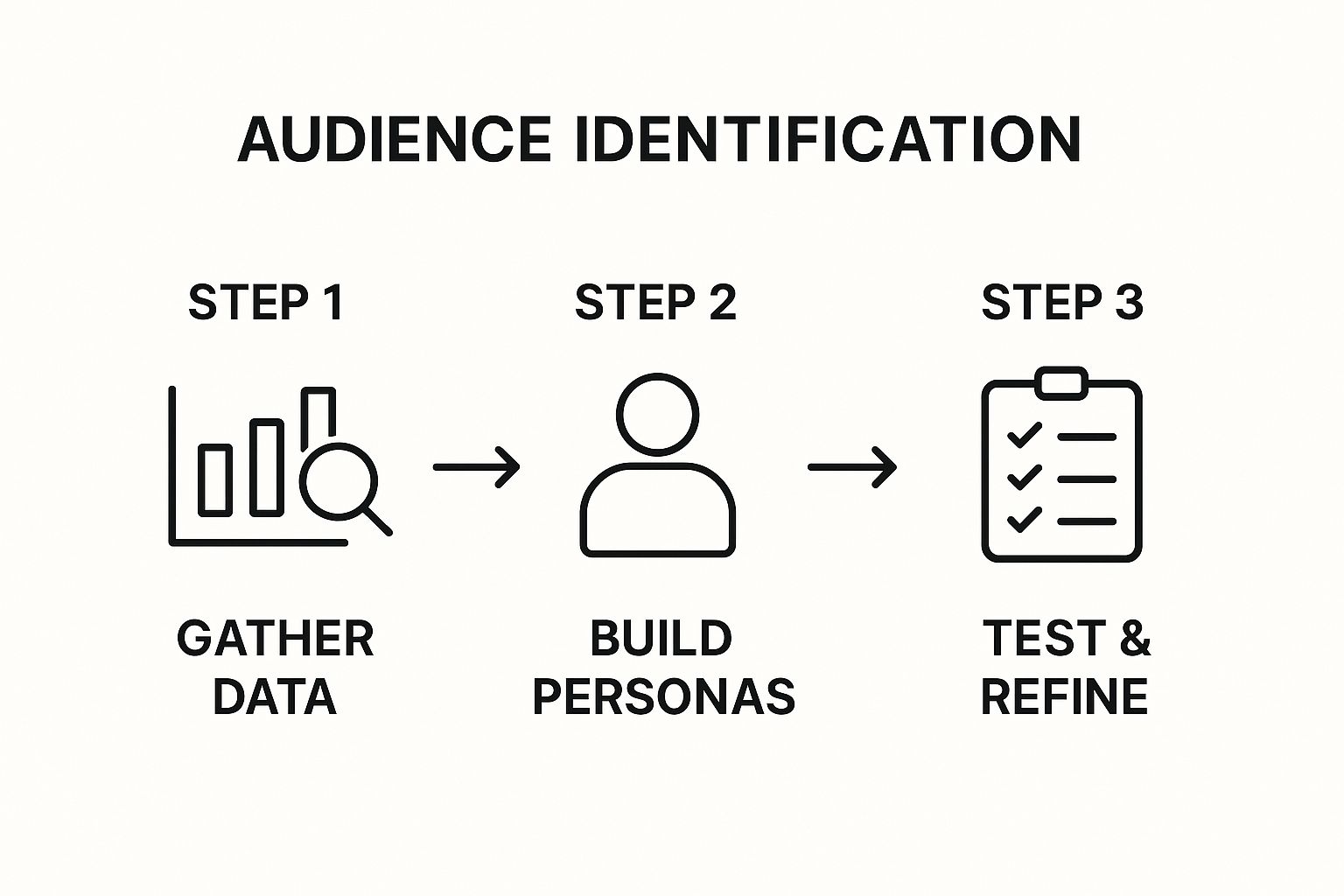
How to Identify Target Audience That Buys
Learn how to identify target audience with actionable strategies. We cover data analysis, persona creation, and real-world validation to fuel your growth.
To nail down your target audience, you have to get your hands dirty with data, build out personas that feel like real people, and never stop testing your assumptions. This isn't a one-and-done checklist item; it’s a core business strategy that stops you from burning through ad spend and ensures your message actually lands.
Why Precision Targeting Beats Casting a Wide Net
Let's be real: marketing to everyone is marketing to no one. In a world flooded with content, generic campaigns don't just flop—they actively drain your budget and make your brand invisible. We need to move past the tired "know your customer" mantra and get honest about the real costs of guessing: rock-bottom engagement, wasted ad dollars, and a message that just doesn't connect.
This guide is all about reframing how you think about identifying your audience. It's an essential, ongoing process, not a one-off task. The sheer scale of the digital world makes this kind of precision non-negotiable.
Think about it: with 5.24 billion social media users across the globe, which is 63.9% of the world's population, just "casting a wide net" is like trying to boil the ocean. The average user is active on 6.8 different platforms every month, which means their attention is more fragmented than ever. Your only hope of cutting through that noise is with a sharp, targeted message.
The Three Pillars of Audience Identification
A structured approach is the key to getting this right. It's not a straight line from A to B; it's a cycle of learning and adapting.
The entire process can be broken down into three core pillars: gathering data, segmenting your findings, and validating those segments with real-world testing. Each stage feeds into the next, creating a loop of continuous improvement.
| Pillar | Objective | Key Activities | | :--- | :--- | :--- | | Data Gathering | To collect raw, unbiased information about your existing and potential customers. | Surveys, customer interviews, analytics review (Google, social), competitor analysis. | | Segmentation | To group your audience into distinct segments based on shared characteristics. | Demographic, psychographic, and behavioral analysis; creating user personas. | | Validation & Testing | To confirm that your defined segments respond to targeted messaging. | A/B testing ads, running small campaigns, analyzing engagement metrics. |
This table maps out the journey from raw information to actionable insights. It’s a repeatable framework that keeps your marketing efforts grounded in reality.

This feedback loop is what separates the pros from the amateurs. You're constantly learning, refining, and getting sharper with every campaign.
The goal isn't just to define who your audience is today. It's to understand them so deeply that you can anticipate their needs tomorrow. That's how marketing shifts from being a cost center to a powerful engine for growth.
When you see how this precision works in practice, it all clicks. For instance, knowing exactly who you're talking to is the foundation for effective Google Ads audience targeting. Every dollar you spend works that much harder.
For a deeper dive into platform-specific strategies, check out our guide to social media audience targeting.
Gathering Actionable Audience Data
To really nail down your ideal customer, you have to think like a data detective. And the first place to look for clues? It's the goldmine you're already sitting on: your existing customer data.
Forget about getting lost in massive spreadsheets. The goal here is to find the patterns that show you who already loves what you do and why.
Your CRM is way more than a glorified contact list; it’s a storybook about your best customers. Start digging into their purchase history. Which products are flying off the shelves, and who's buying them? You might find out that your high-ticket service is a surprise hit with a demographic you weren't even trying to reach.
And don't overlook your customer support tickets. Those aren't just problems to solve—they're direct lines into your audience's biggest frustrations and needs. Recurring questions are a roadmap for future content and product tweaks.

Uncovering Insights with Digital Tools
Once you’ve squeezed every last drop of insight from your own data, it's time to look outward. Digital analytics tools and social media platforms are overflowing with information about both your current audience and the people who could be.
Google Analytics is your first stop. Head straight for the demographics and interests reports. This is where your assumptions get either validated or completely blown out of the water. You can see the real age, gender, and even affinity categories (like "tech enthusiasts" or "home decor lovers") of the people browsing your site.
Let’s say you’ve been marketing to millennials this whole time, but Analytics shows a fast-growing segment of Gen X professionals are the ones really engaging with your content. Boom. That single discovery lets you pivot and create campaigns that speak directly to their specific challenges, instead of sticking with a message that doesn't quite land.
Analyzing Competitor and Social Data
Spying on your competitors isn't about being petty; it's just smart research. Take a look at who's engaging with their content. What kind of language do their followers use? What questions are they asking? Which posts get the most love? This gives you a clear picture of who is active in your market and what makes them tick.
Social media is where your audience hangs out and speaks their mind. This is your chance to go beyond simple metrics and start genuinely listening. By keeping an eye on conversations around your industry, you can pick up on new trends, common complaints about other solutions, and the exact words people use to describe their problems. For this, it’s crucial you’re understanding the difference between social listening and monitoring, as they each give you a different piece of the puzzle.
The real goal isn't just to collect data points, but to connect them. Knowing that 72% of your customers are female is a fact. Understanding why they choose you over a competitor by analyzing their social media feedback—that's a true, actionable insight.
This whole process is about finding patterns across different platforms. What are people saying on Reddit forums compared to what they're posting on Instagram? Piecing these observations together gives you a much richer, three-dimensional view of your potential customer.
You can even organize your findings to compare what you’re learning from different places:
| Data Source | Information Gathered | Potential Insight | | :--- | :--- | :--- | | CRM Data | Purchase frequency, average order value | Identify your high-value customers who deserve the VIP treatment. | | Google Analytics | Top landing pages by user demographic | Figure out which parts of your message hit home with specific age groups. | | Competitor Socials | Follower comments and questions | Spot the gaps in the market or unmet needs that you can swoop in and solve. |
By pulling together data from inside your business and out in the wild, you move from pure guesswork to a solid, data-driven foundation. This raw information is the bedrock you'll use to build customer personas that actually work.
Translating Data into Deeper Human Insights

Raw data gives you a map, but understanding what makes your audience tick is the compass. Having demographic info like age, location, and income is a solid start, but it really only tells you who your customers are. To actually connect with them, you have to dig into the why behind their decisions.
This is where you bridge the gap between hard numbers and real human behavior.
Demographics are still crucial because they heavily influence where people spend their time and how they spend their money. Age, for example, is a huge factor in platform usage. Over 90% of U.S. adults aged 18-49 are on YouTube, but that number drops to just 65% for folks over 65. Meanwhile, Facebook’s sweet spot is the 25-34 crowd, and Instagram skews even younger.
It’s a clear sign that different age groups hang out in different digital spaces. If you want to dive deeper, you can explore more social media demographic breakdowns to get laser-focused with your channel strategy.
Going Beyond Demographics with Psychographics
If demographics sketch the outline of your audience, psychographics are what color it in with vibrant, actionable detail. This is where the real magic happens. Psychographics unlock the internal drivers that actually lead to a purchase.
You’re essentially digging into your audience's:
- Core Values: What principles guide their big life decisions? Do they prioritize sustainability, convenience, or social status?
- Daily Habits: What does a day in their life look like? Where do they get their news? When do they doom-scroll on social media?
- Biggest Frustrations: What are the recurring problems or little annoyances they face that your product could wipe away?
- Aspirations and Goals: What are they trying to achieve, either personally or professionally?
Answering these questions transforms a flat customer profile into a living, breathing person with real motivations you can speak to directly.
A customer's lifestyle dictates the content they crave, and their values shape their brand loyalty. Someone who values efficiency wants quick, scannable blog posts. Someone who values community wants to see user-generated content and testimonials.
Connecting the Dots for a Complete Picture
The final move is to stitch it all together. How do demographics and psychographics intersect to create a complete customer profile? You can start by mapping these connections to see how one influences the other.
Imagine a SaaS company selling project management software. Their data might point to two totally different segments:
| Customer Segment | Demographics | Psychographics (The "Why") | | :--- | :--- | :--- | | The Freelance Hustler | Age: 25-35, Urban, Lower-Mid Income | Values flexibility and autonomy. Frustrated by disorganized clients and juggling multiple projects. Aspires to scale their business without burning out. | | The Agency Manager | Age: 35-50, Suburban, Upper-Mid Income | Values team efficiency and clear reporting. Frustrated by missed deadlines and poor communication. Aspires to improve project profitability and client retention. |
See how different the messaging needs to be? The Freelance Hustler wants to hear about "taking back control" and "streamlining your workflow." The Agency Manager, on the other hand, is much more interested in "improving team collaboration" and "data-driven insights."
This is the level of understanding that lets you create marketing that feels personal and genuinely helpful—and it’s a world away from basic targeting.
Building Customer Personas That Actually Work
All that data you've gathered? It’s pretty much useless until you shape it into a living, breathing guide for your marketing. This is where you create customer personas—data-backed archetypes of your ideal buyers that go way beyond a simple fictional bio.
A great persona turns abstract numbers into a relatable character your whole team can rally around. It’s about giving a human face to your data. When you get this right, your persona becomes the North Star for everything from email copy to product development, ensuring you’re always talking to a real person with real problems.

From Data Points to a Day in the Life
First things first, give your persona a name and a stock photo. It might seem like a small detail, but this simple step makes them feel instantly more real than "Segment B." From there, you start layering in the essential details you've collected.
A truly useful persona isn't just a list of facts; it paints a picture of who they are and what they need from you. Here’s what you absolutely have to include.
Essential Components of a Customer Persona
To make your persona actionable, you need to build a complete profile. The table below breaks down the must-have elements that transform a persona from a document into a strategic tool.
| Component | Description | Example | | :--- | :--- | :--- | | Demographics | The basic facts that provide context for their lifestyle and purchasing power. | Age, job title, income level, location. | | Goals & Motivations | What are they ultimately trying to achieve? This is the "what" that drives them. | Trying to grow their business, get a promotion, or save time on daily tasks. | | Frustrations & Pain Points | The daily hurdles and annoyances standing in their way. This is where you fit in. | Wasting time on manual tasks, struggling to find reliable information, feeling overwhelmed. | | Watering Holes | Where do they go for information and community? This tells you exactly where to find them. | Specific blogs, social media platforms, influencers, podcasts, or online forums. |
By filling in these key areas, you create a character that feels authentic and gives your team clear direction.
The most powerful personas I've seen always include real quotes pulled directly from research. A snippet from a customer survey or a comment from a social media post brings their voice to life in a way bullet points never can. For a more detailed walkthrough, our complete guide on how to create buyer personas breaks down the entire process.
A well-crafted persona should feel so real that you could almost have a conversation with them. If you can anticipate their objections and questions, you've nailed it.
A Practical Persona Example in Action
Let's make this tangible. Imagine a company that sells an AI-powered social media scheduling tool. After doing their research, they create a persona called "Startup Sarah."
Here’s what that looks like:
- Name & Photo: Sarah Chen (paired with a stock photo).
- Demographics: 29, Founder of a direct-to-consumer sustainable skincare brand, lives in NYC, $75k income.
- Goals: Increase online sales by 30% this quarter and build a strong, engaged community on Instagram.
- Frustrations: "I spend hours every day trying to come up with content ideas and manually posting. I feel like I'm always behind and never have time for big-picture strategy."
- Watering Holes: Follows Gary Vaynerchuk and Amy Porterfield; listens to "The Social Media Marketing Podcast"; active in female founder groups on Facebook.
Suddenly, the target audience isn’t a vague concept. It's Sarah.
When the marketing team writes ad copy, they know to hit on "saving time" and "automating content creation." When the product team develops new features, they'll prioritize tools for content ideation and community engagement. This is how you take raw data about your target audience and turn it into a powerful, actionable asset.
Time to Test and Refine Your Audience Strategy
So, you've got your beautifully crafted customer persona. It feels right. It makes sense. But right now, it's just a powerful hypothesis, not a proven fact.
The final, and most important, step is to put that hypothesis to the test in the real world. This is where you find out if your assumptions hold up and build a feedback loop that keeps your marketing sharp. Think of it like the scientific method for your business. You have a theory about who your customer is and what they care about. Now it's time to run a few experiments to see if you're right.
From Educated Guesses to Hard Data
The goal here is simple: move from "I think" to "I know." You need to see how your theoretical persona actually behaves when they see your ad, open your email, or scroll past your social post. Thankfully, you can do this without blowing your budget.
Start with small, targeted campaigns designed to test one thing at a time. For instance, run two nearly identical Facebook ad campaigns, but aim each one at a slightly different segment of your persona. Does "Startup Sarah" click on an ad highlighting time-saving features, or one focused on community building? The click-through and conversion rates will give you a clear winner.
Here are a few other simple but effective ways to validate your ideas:
- Social Media Polls: Toss up a quick poll on Instagram Stories or X. Ask a simple question that confirms or denies one of your persona's core pain points. It’s fast, easy, and gives you direct feedback.
- Customer Interviews: Find a handful of your best customers—the ones who perfectly embody your persona. A quick 15-minute chat can uncover invaluable insights into what really motivates them.
- Email A/B Tests: Split a small segment of your email list and test different subject lines or value propositions. Which message earns more opens and clicks? The data doesn't lie.
The most dangerous assumption in marketing is thinking you know your audience without ever asking them. Testing isn't a weakness; it's a commitment to getting it right.
Creating an Agile Feedback Loop
What happens if a campaign aimed squarely at your persona completely flops? That's not a failure—it's a critical piece of data. Now you get to play detective. Why didn't it connect? Maybe you got their primary "watering hole" wrong, or the pain point you focused on just wasn't as urgent as you believed.
This is also where paying attention to platform-specific behavior pays off. For e-commerce brands, knowing that 39% of users have bought something directly through Facebook, with TikTok close behind at 36%, is huge. That kind of data, like these new social media demographics from Sprout Social, tells you where to test your messages that are designed to drive immediate sales.
This cycle of testing, learning, and refining is what transforms a static persona document into a dynamic, living strategy. For example, if an A/B test shows that a certain ad creative is crushing it, you can apply those visual and messaging cues to your landing pages. This constant refinement is a key part of our approach to conversion rate optimization tips. Your audience is always evolving, and your understanding of them should be, too.
Got Questions About Target Audience Research?
Even with a solid plan, a few practical questions always pop up once you start digging into audience research. It's totally normal. Let's tackle some of the most common hurdles marketers run into.
Think of this as your troubleshooting guide. These are the real-world "what ifs" that can slow you down if you're not ready for them.
How Many Customer Personas Should I Actually Make?
It’s tempting to create a persona for every slice of your potential audience, but that usually just dilutes your focus. The best way to go? Start small and go deep.
Focus on building just one or two incredibly well-researched personas. These should represent your most valuable, most profitable customers first. Trust me, it's way more effective to have a single, detailed persona your whole team gets than five shallow ones that don't offer any real direction.
Once you’ve nailed your marketing for that core group, you can always expand and build out secondary personas for other groups you find along the way.
What If My Product Is for a Bunch of Different Audiences?
First off, that’s a great problem to have, and it happens all the time. When your product has broad appeal, the name of the game is prioritization.
Start by identifying your primary persona. This is the core group that gets the most out of your product and is most critical to your business's success. This is where the bulk of your marketing budget and energy should go.
Then, create secondary personas for the other important segments. You won't ignore them, but you’ll talk to them a bit differently. You might create specific campaigns or content just for them without overhauling your main strategy. For instance, maybe your primary marketing happens on Instagram, but you run a targeted LinkedIn campaign for a secondary B2B persona.
Prioritizing your personas keeps your main message strong and consistent, while still letting you connect with other valuable segments in a way that makes sense to them. It stops your marketing from becoming generic.
How Often Should I Update My Customer Personas?
Your personas aren't meant to be carved in stone. Markets change, customer habits evolve, and your own products grow. Think of them as living documents that need a refresh every now and then to stay useful.
A good rule of thumb is to give them a formal review at least once a year. But you should also plan to update them anytime something big happens, like:
- A major shift in market trends or how people are behaving.
- You launch a new product or a major update to an old one.
- Your data shows a change, like a new demographic suddenly buying from you.
Keeping an eye on your data and listening to customer feedback is your best bet. When your assumptions no longer line up with who's actually buying from you, it's time for a refresh.
Ready to stop guessing and start creating content that actually connects? With ViewPrinter, you can build dynamic, AI-powered content tailored directly to your ideal customer personas. Generate viral slideshows, create custom avatars, and schedule posts across all your platforms in minutes. Discover how at https://viewprinter.tech.